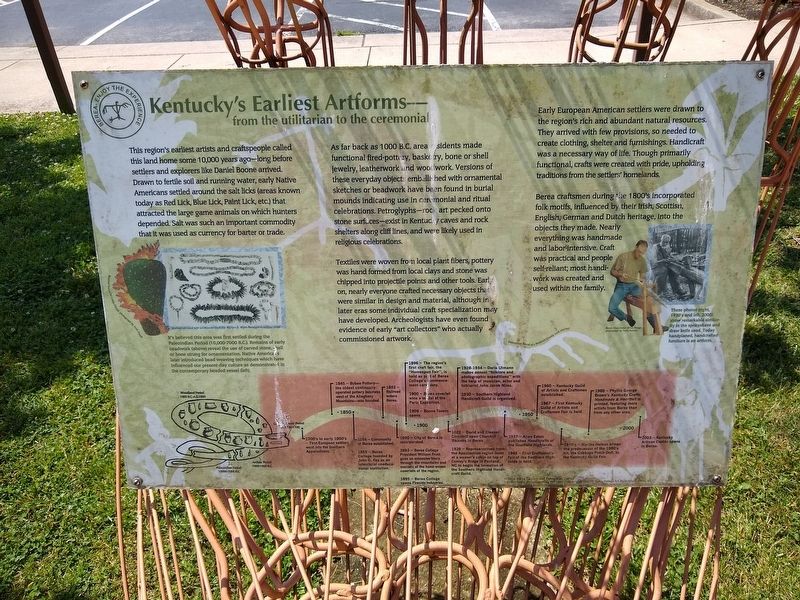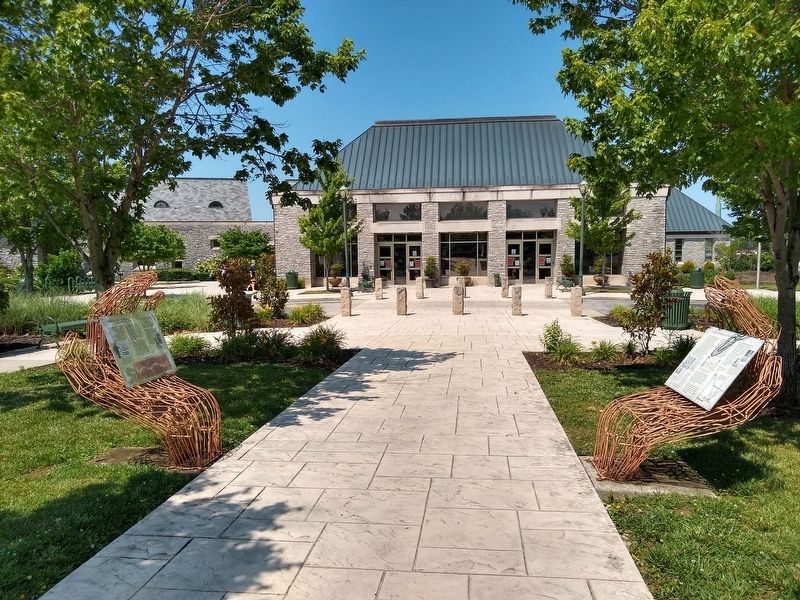Berea in Madison County, Kentucky — The American South (East South Central)
Kentucky's Earliest Artforms
From the utilitarian to the ceremonial
This regions earliest artist and craftspeople called this land home some 10,000 years ago – long before settler and explorers like Daniel Boone arrived. Drawn to fertile soil and running water, early Native Americans settled around the salt licks (areas known today as Red Lick, Blue Lick, Paint Lick, etc.) that attracted the large game animals on which hunters depended. Salt was such an important commodity that it was used as currency for barter or trade.
As far back as 1000 B.C. area residents made functional fired-pottery, basketry, bone or shell jewelry, leatherwork and woodwork. Versions of these everyday objects embellished with ornamental sketches or beadwork have been found in burial mounds indicating use in ceremonial and ritual celebrations. Petroglyphs – rack art pecked onto stone surfaces – exist in Kentucky caves and rock shelters along cliff lines, and were likely used in religious celebrations.
Textiles were woven from local plant fibers, pottery was hand formed from local clays and stone was chipped into projectile points and other tools. Early on, nearly everyone crafted necessary objects that were similar in design and material, although in later eras some individual craft specialization may have developed. Archeologists have even found evidence of early “art collectors” who actually commissioned artwork.
Early European American settlers were drawn to the region’s rich and abundant natural resources. They arrived with few provisions, so needed to create clothing, shelter and furnishings. Handicraft was a necessary way of life. Though primarily functional, crafts were created with pride, upholding traditions from the settlers’ homelands.
Berea craftsmen during the 1800’s incorporated folk motifs, influenced by their Irish, Scottish, English, German and Dutch heritage, into the objects they made. Nearly everything was handmade and labor-intensive. Craft was practical and people self-reliant; most handiwork was created and used within the family.
[Insert]
It’s believed this area was first settled during the Paleo-Indian Period (10,000 – 7,000 B.C.). Remains of early beadwork (above) reveal the use of carved stone, shell or bone strung for ornamentation. Native Americas later introduced bead weaving techniques which have influenced our present-day culture as demonstrated in the contemporary beaded vessel(left).
These photos (right, 1930’s and left, 2005) show remarkable similarity in the spokeshave and draw knife use. Today handplaned, handcrafted furniture is an artform.
[Timeline:]
Paleo-Indian Period 10000 – 7000 B.C.
Archaic Period 7000 – 1000 B.C.
Woodland Period 1000 B.C. – A.D. 1000
Late [unreadable] Period 1000 - 1700
1700’s to early 1800’s ~ First European settlers went in the Southern Appalachians.
1845 ~ Bybee Pottery – the oldest continually operated pottery business west of the Allegheny Mountains – was founded.
1854 ~ Community of Berea established.
1855~ Berea College founded by John G. Fee as an interracial coeducational institution.
1883 ~ Railroad enters Berea
1890 ~ City of Berea is incorporated.
1893 ~ Berea College President William Frost goes on extensive tours through the mountains and marvels at the hand-woven coverlets of the region.
1895 ~ Berea College opens Fireside Industries
1896 ~ The region’s first craft fair, the “Homespun Fair”, is held as part of Berea College’s commencement ceremony.
1900 ~ Berea coverlet wins a medal at the Paris Exposition
1909 ~ Boone Tavern opens
1922 ~ David and Eleanor Churchill open Churchill Weavers in Berea
1928 ~ Representatives from the Appalachian region meet at a weaver’s cabin on top of Conley’s Ridge in Penland, NC to begin the formation of the Southern Highland Handicraft Guild.
1928-1934 ~ Doris Ulmann makes annual “folklore and photographic expeditions” with the help of musician, actor and folklorist John Jacob Niles.
1930 ~ Southern Highland Handicraft Guild is organized.
1937 ~ Allen Eaton publishes Handicrafts of the Southern Highlands.
1948 ~ First Craftmen’s Fair of the Southern Highlands is held.
1960 ~ Kentucky Guild of Artists and Craftsmen established.
1967 ~ First Kentucky Guild of Artists and Craftsmen Fair is held.
1970s ~ Martha Nelson brings the predecessor of the 1980’s hit, the Cabbage Patch Doll, to the Kentucky Guild Fair.
1988 ~ Phyllis George Brown’s Kentucky Crafts: Handmade & Heartfelt is printed, featuring more artists from Berea than from any other area.
2003 ~ Kentucky Artisan Center opens in Berea.
Erected by Berea Tourism.
Topics. This historical marker is listed in these topic lists: Arts, Letters, Music • Education • Industry & Commerce • Native Americans • Settlements & Settlers.
Location. 37° 35.792′ N, 84° 18.711′ W. Marker is in Berea, Kentucky, in Madison County. Marker is on Artisan Way, 0.3 miles west of Walnut Meadow Road (Kentucky Route 595), on the left when traveling west. Marker located at the Kentucky Artisan Center at Berea. Touch for map. Marker is at or near this postal address: 200 Artisan Way, Berea KY 40403, United States of America. Touch for directions.
Other nearby markers. At least 8 other markers are within 6 miles of this marker, measured as the crow flies. Berea – A Birthplace of the Handicraft Revival (here, next to this marker); The Battle of Richmond Knocked at Berea's Door (approx. 2.1 miles away); Church of Christ, Union (approx. 2.1 miles away); Encampment at Bobtown / Engagment at Bobtown / Advance to Kingston (approx. 4.8 miles away); Madison Hemp And Flax Co. / Hemp in Kentucky (approx. 5.1 miles away); Richmond-Prelude/ Richmond Battle (approx. 5.4 miles away); The Battle Begins (approx. 5½ miles away); Fort Paint Lick (approx. 5½ miles away). Touch for a list and map of all markers in Berea.
Related marker. Click here for another marker that is related to this marker.
Also see . . . Kentucky Artisan Center. (Submitted on June 23, 2020, by Tom Bosse of Jefferson City, Tennessee.)
Credits. This page was last revised on June 23, 2020. It was originally submitted on June 23, 2020, by Tom Bosse of Jefferson City, Tennessee. This page has been viewed 236 times since then and 29 times this year. Photos: 1, 2. submitted on June 23, 2020, by Tom Bosse of Jefferson City, Tennessee. • Devry Becker Jones was the editor who published this page.

